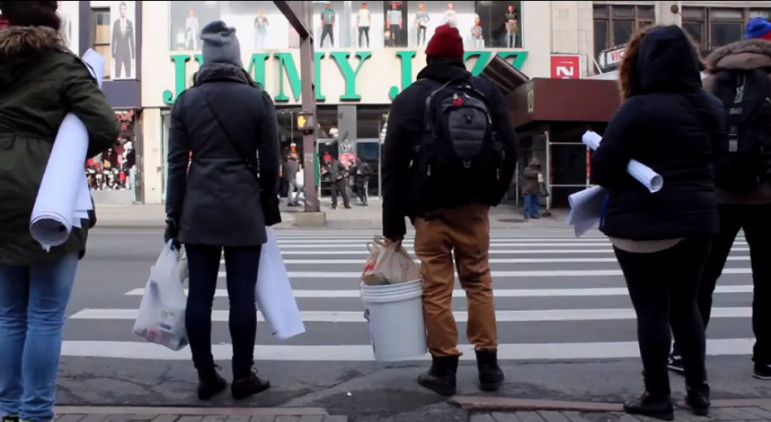
Kathleen Caulderwood
Artist Damon Davis and his team.
When St. Louis artist Damon Davis started his latest project in Ferguson a few months ago, he thought that’s where it would stay. But his posters, which depict two hands held up against a white background, are now up in cities around the country.
“I didn’t expect it to go any bigger than St. Louis,” he said in January from Washington, D.C. “But eventually I saw the opportunity to meet with other people in other places, to learn about the Mike Browns in other places.”
The phrase “hands up, don’t shoot” was first used by protesters in Ferguson, Missouri after a white police officer shot and killed 18-year-old Michael Brown, to represent the gesture some believe he was making before his death — though nobody knows for sure.
Witness accounts vary. Some insist Brown was holding his hands up in surrender when he was shot, others say he was “charging” or had one hand in his waistband.
A report from the St. Louis County medical examiner says that Brown did not have his hands up, but was running towards Wilson before he was shot. Forensic pathologists told reporters that, despite the fact that Brown was shot twice in his right arm, the trajectory of the bullets indicated his hands were likely not held above his head.
In his own testimony, Wilson, who was never charged, said that Brown did have his hands up — but it wasn’t a gesture of surrender. “The only way I can describe it, it looks like a demon, that’s how angry he looked. He comes back towards me again with his hands up,” he told the grand jury.
“The official statement doesn’t mean anything to me,” Davis said. “It is propaganda. The people say he had his hands up. Everyone I have met has the same story. So it is the truth, not what the news says.”
For him and other activists these specifics have fallen away as the phrase “hands up” became a motto for the growing protest movement around the United States that sparked a new conversation about race, police and use of force.
“It’s a lot deeper than just the one incident, the public has galvanized around these specific cases,” said Davis. “These hands, that symbol, I think it’s forever, it’s going to be historic.”
To create the posters, Davis used images of hands belonging to prominent people in the movement. But none of them are identified.
“I picked those people because I knew them and I knew what they did. But it’s more about everybody, that’s why there are no faces,” he said. “It shouldn’t matter who they are. And that’s the point.
In December, Davis met with activists outside the Apollo Theatre in New York. Together, they walked the streets with paint rollers, posters and glue, putting up the large images on outside walls around Harlem. Some people walking by simply kept going, others paused for a moment, and others stopped to take a photo, or have a conversation.
Davis said the reaction should depend on each viewer.
“It’s meant to make the comfortable people uncomfortable and give the uncomfortable people hope,” he said.







